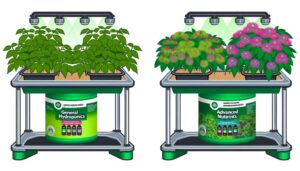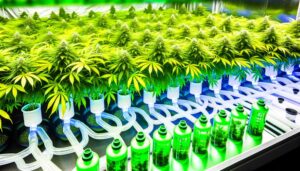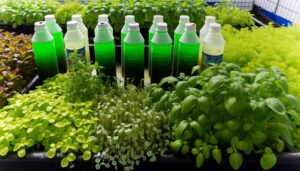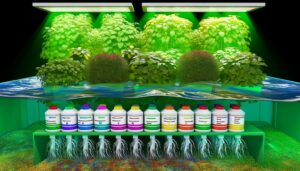Hydroponic Nutrient Solution for Cucumbers
Hydroponically cultivated cucumbers necessitate a precise balance of essential nutrients for peak development. The recommended macronutrient N:P:K ratio is 2:1:3, featuring nitrogen (150-200 ppm), phosphorus (50-70 ppm), and potassium (200-300 ppm).
Micronutrients such as calcium (150-200 ppm), magnesium (50-70 ppm), and trace elements like iron and manganese are vital for metabolic and structural integrity. Maintaining a pH range of 5.8-6.2 and EC levels between 1.8-2.4 mS/cm is critical to prevent nutrient lockout.
Regular monitoring and adjustments guarantee robust growth and fruit production. Further details illuminate specific deficiencies and corrective measures.
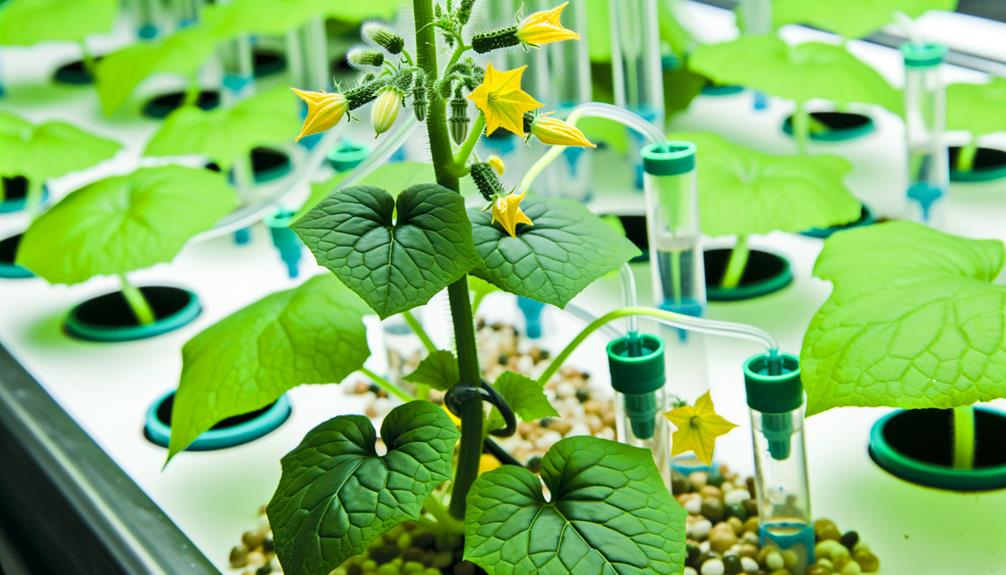
Key Takeaways
- Maintain a nutrient solution pH between 5.8 and 6.2 for optimal nutrient uptake in cucumbers.
- Use a 2:1:3 N:P:K ratio to support cucumber vegetative growth, root development, and fruit quality.
- Monitor Electrical Conductivity (EC) levels between 1.8 and 2.4 mS/cm to avoid nutrient imbalances.
- Regularly check for micronutrient deficiencies and adjust nutrient concentrations accordingly to prevent chlorosis and stunted growth.
Essential Nutrients

Hydroponically grown cucumbers necessitate a thorough suite of nutrients to enhance growth and yield. Key essential nutrients include nitrogen (N), phosphorus (P), and potassium (K), essential for vegetative growth, root development, and fruit production.
Micronutrients such as calcium (Ca), magnesium (Mg), and sulfur (S) are critical for structural integrity and enzymatic functions.
Trace elements like iron (Fe), manganese (Mn), zinc (Zn), boron (B), copper (Cu), and molybdenum (Mo) are indispensable for metabolic processes and chlorophyll synthesis.
Data-driven cultivation practices highlight the importance of maintaining precise nutrient concentrations and a balanced pH level, typically around 5.8-6.2, to guarantee peak nutrient uptake and robust cucumber growth.
Macronutrient Ratios
Determining the ideal macronutrient ratios is critical for maximizing the growth and productivity of hydroponically grown cucumbers. Research indicates suitable ratios of Nitrogen (N), Phosphorus (P), and Potassium (K) are essential.
A common recommendation is an N:P:K ratio of 2:1:3. Nitrogen supports vegetative growth, while phosphorus enhances root development, and potassium promotes fruit quality and disease resistance.
Empirical data suggests maintaining nitrogen levels around 150-200 ppm, phosphorus at 50-70 ppm, and potassium at 200-300 ppm. Additionally, calcium (Ca) and magnesium (Mg) should be maintained at 150-200 ppm and 50-70 ppm, respectively, to prevent deficiencies.
Regular monitoring and adjusting of these macronutrients confirm nutrient availability aligns with the plant's developmental stages, fostering robust growth.
Micronutrient Importance
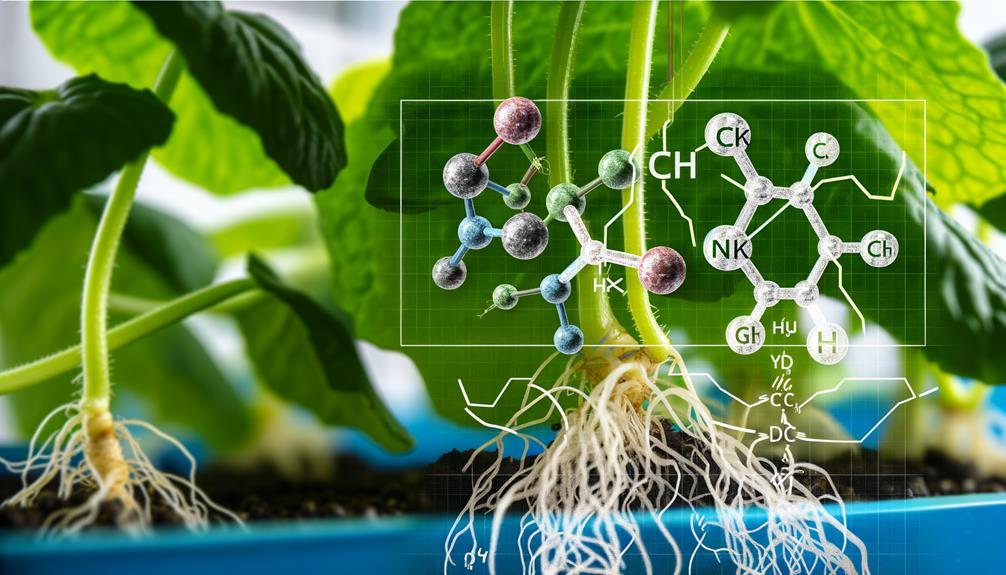
Micronutrients, including essential trace elements such as zinc, copper, and manganese, play a critical role in the ideal growth and yield of hydroponic cucumbers.
Deficiencies in these nutrients can manifest as chlorosis, stunted growth, and reduced fruit quality, which can be mitigated through precise monitoring and supplementation.
For instance, a zinc deficiency can lead to interveinal chlorosis on younger leaves, emphasizing the need for a balanced nutrient solution.
Essential Trace Elements
Essential trace elements, such as iron, manganese, zinc, copper, molybdenum, and boron, play an important role in the ideal growth and development of hydroponically-grown cucumbers by facilitating key physiological processes and enzymatic functions.
These micronutrients, though required in minute quantities, are indispensable for peak plant health.
- Iron (Fe): Critical for chlorophyll synthesis, iron greatly impacts photosynthesis efficiency.
- Manganese (Mn): Integral in nitrogen assimilation and enzyme activation, manganese enhances metabolic processes.
- Zinc (Zn): Important for hormone regulation and protein synthesis, zinc contributes to robust growth and stress resistance.
Precise maintenance of these trace elements, in balanced proportions, is essential to prevent physiological disorders and guarantee maximum yield potential in hydroponic cucumber cultivation.
Nutrient Deficiency Symptoms
Understanding the symptoms of nutrient deficiencies is paramount for diagnosing and correcting imbalances in hydroponic cucumber systems, guaranteeing ideal plant health and productivity.
Micronutrient deficiencies can manifest in various forms: Iron (Fe) deficiency typically causes interveinal chlorosis in young leaves, while Manganese (Mn) deficiency results in dark green veins and chlorotic areas. Zinc (Zn) deficiency leads to stunted growth and small, distorted leaves. Boron (B) deficiency might cause brittle leaves and poor fruit set.
Regularly monitoring Electrical Conductivity (EC) and pH levels, alongside visual inspections, can help identify these issues early. Corrective measures include adjusting nutrient concentrations or foliar applications of deficient elements.
Consistent vigilance guarantees a balanced nutrient solution, optimizing cucumber yield and quality.
Water Quality
Guaranteeing ideal water quality is essential for the effectiveness of hydroponic nutrient solutions in cucumber cultivation, necessitating precise control over parameters such as pH, electrical conductivity, and dissolved oxygen levels.
Optimizing water quality enhances nutrient uptake and plant health, leading to robust growth and higher yields.
Key factors to monitor include:
- Water Source: Utilize filtered or distilled water to minimize contaminants and guarantee consistency in nutrient delivery.
- Electrical Conductivity (EC): Maintain EC levels between 1.8-2.4 mS/cm, as deviations can lead to nutrient imbalances or toxicity.
- Dissolved Oxygen (DO): Ascertain DO levels are above 6 mg/L to promote root respiration and prevent anaerobic conditions.
Ph Levels
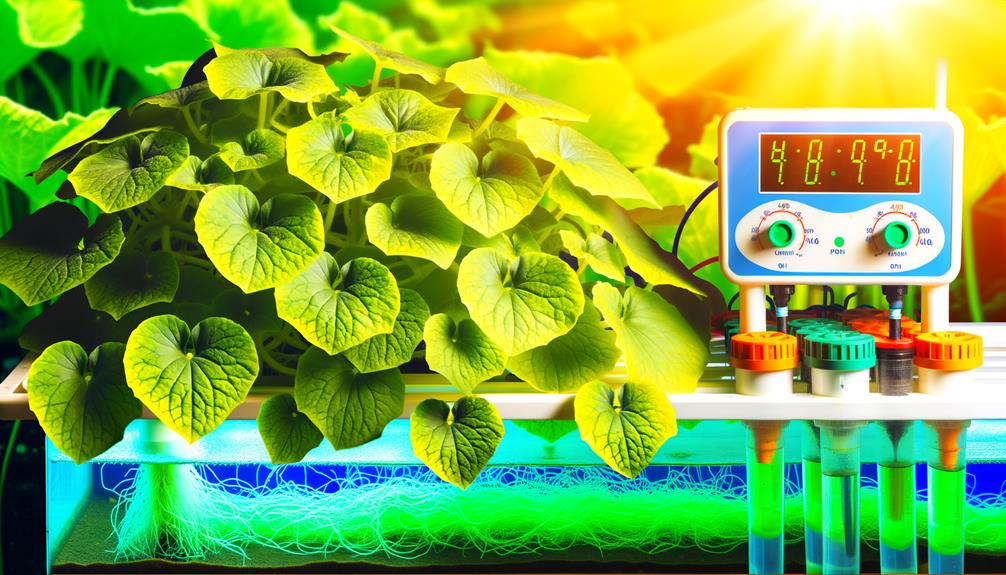
Maintaining precise pH levels between 5.5 and 6.5 is critical for ideal nutrient availability and uptake in hydroponic cucumber systems.
Suitable pH guarantees that essential macro and micronutrients, such as nitrogen, potassium, and iron, remain soluble and readily absorbable by plant roots.
Regular monitoring using a calibrated pH meter is recommended to detect fluctuations promptly. Deviations outside this range can lead to nutrient lockout, resulting in deficiencies or toxicities.
To adjust pH levels, use pH up (potassium hydroxide) or pH down (phosphoric acid) solutions. Consistent pH management not only promotes vigorous growth but also enhances disease resistance and fruit quality, guaranteeing a robust yield.
Implementing automated pH control systems can further streamline this critical aspect of hydroponic cultivation.
Nutrient Solution Preparation
To prepare an ideal hydroponic nutrient solution for cucumbers, one must carefully balance essential nutrient components such as nitrogen, phosphorus, and potassium, alongside trace minerals.
Accurate mixing ratios are vital; for instance, a typical recommendation might include 200 ppm nitrogen, 50 ppm phosphorus, and 250 ppm potassium.
Additionally, maintaining appropriate pH levels (5.8-6.2) and electrical conductivity (EC) values (2.0-2.5 mS/cm) guarantees nutrient availability and prevents deficiencies.
Essential Nutrient Components
The formulation of a hydroponic nutrient solution for cucumbers necessitates a precise balance of macronutrients, including nitrogen, phosphorus, and potassium, as well as essential micronutrients such as magnesium, calcium, and iron.
Ensuring ideal plant growth requires the following:
- Nitrogen (N): Essential for vegetative growth, it supports protein synthesis and leaf development. Ideal concentration ranges from 150-200 ppm.
- Phosphorus (P): Important for root development and flowering, it should be maintained at 30-50 ppm.
- Potassium (K): Key for water regulation and disease resistance, recommended levels are 200-250 ppm.
These components must be meticulously measured and balanced to sustain healthy cucumber growth, ensuring maximum yield and fruit quality.
Proper monitoring and adjustments are fundamental for maintaining nutrient efficacy.
Mixing Ratios Guide
Achieving the ideal mixing ratios for a hydroponic nutrient solution involves precise calculations based on the specific growth stage and nutritional requirements of the cucumber plants. Proper nutrient calculations for hydroponics ensure that essential elements like nitrogen, phosphorus, and potassium are supplied in optimal concentrations to support healthy root development and vigorous growth. Factors such as water quality, pH levels, and temperature must also be considered to maintain nutrient availability and prevent deficiencies or toxicities. Regular monitoring and adjustments help sustain a balanced solution, promoting higher yields and better fruit quality.
During the vegetative stage, a common recommendation is to maintain a nitrogen (N) to potassium (K) ratio of 3:1, with phosphorus (P) levels adjusted to support root development.
Conversely, during the fruiting phase, the ratio should shift to 1:3 to enhance fruit quality and yield.
Essential micronutrients such as magnesium (Mg), calcium (Ca), and iron (Fe) must be meticulously balanced, typically maintained at 30-50 ppm, 100-150 ppm, and 2-3 ppm respectively.
Accurate measurement and adjustment of these ratios are critical for peak plant health and productivity in hydroponic cucumber cultivation.
Ph and EC Levels
Maintaining ideal pH and Electrical Conductivity (EC) levels is essential for guaranteeing nutrient availability and uptake efficiency in hydroponic cucumber systems.
Ideal pH should range between 5.8 and 6.2 to maximize nutrient solubility. Deviating from this range can lead to nutrient lockout, impeding plant growth.
EC, measured in milliSiemens per centimeter (mS/cm), should be maintained between 1.8 and 2.4 mS/cm for cucumbers. This range guarantees adequate nutrient concentration without risking osmotic stress.
Key steps for maintaining pH and EC:
- Regular Monitoring: Use a reliable pH and EC meter daily.
- Adjustments: Use pH up/down solutions and adjust nutrient concentration accordingly.
- Record Keeping: Document readings to identify trends and make informed adjustments.
These practices enhance cucumber growth and yield.
Monitoring and Adjusting
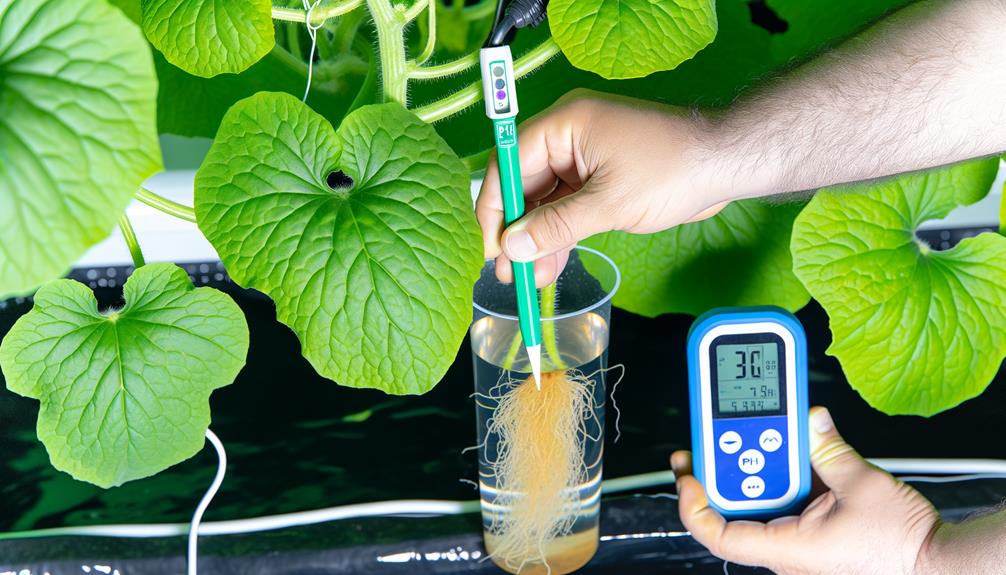
Regular monitoring and precise adjustment of the hydroponic nutrient solution are essential for optimizing cucumber growth and yield.
Utilizing tools such as pH meters and electrical conductivity (EC) sensors, growers should maintain pH levels between 5.5 and 6.0 and EC values from 1.8 to 2.4 mS/cm. Daily checks guarantee consistency, preventing nutrient lockout and toxicity.
Adjustments may include dilution with distilled water or the addition of specific nutrients to maintain balance. Automated dosing systems can offer precision, though manual adjustments allow for immediate correction based on real-time data.
Regularly calibrate measurement instruments to prevent inaccuracies. Consistent monitoring facilitates early detection of nutrient imbalances, guaranteeing robust growth and maximizing cucumber production.
Common Deficiencies
In hydroponic cucumber cultivation, common nutrient deficiencies can greatly impact plant health and yield.
Symptoms of nitrogen deficiency include chlorosis in older leaves, while magnesium deficiency often manifests as interveinal chlorosis.
Additionally, calcium shortages can lead to blossom end rot, necessitating precise adjustments in the nutrient solution to mitigate these issues.
Nitrogen Deficiency Symptoms
Frequently, nitrogen deficiency in cucumbers manifests through chlorosis of older leaves, resulting in a pale yellow coloration that can be quantified by measuring reduced chlorophyll content. This deficiency can detrimentally impact plant growth and fruit yield.
Key indicators include:
- Stunted Growth: Nitrogen is vital for vegetative growth, and its deficiency leads to reduced plant height and smaller leaves.
- Delayed Flowering: Insufficient nitrogen delays the onset of flowering, thereby extending the overall growth cycle.
- Reduced Yield: The lack of nitrogen results in fewer and smaller cucumbers, directly impacting the economic viability of the crop.
To mitigate these issues, it is essential to monitor nutrient levels continuously and adjust the hydroponic solution accordingly, ensuring ideal nitrogen availability for cucumber plants.
Magnesium Deficiency Indicators
Magnesium deficiency in cucumbers is often characterized by interveinal chlorosis on older leaves, leading to a mottled appearance and reduced photosynthetic efficiency. This deficiency disrupts chlorophyll synthesis, manifesting as yellowing between veins while veins remain green.
Quantitatively, leaf tissue analysis should reveal magnesium levels below 0.20% dry weight, indicating a deficiency. Hydroponically, ideal magnesium concentration in the nutrient solution should be maintained between 40-60 ppm.
Practical measures include using magnesium sulfate (Epsom salts) as an additive. Monitoring electrical conductivity (EC) and pH regularly is essential, as imbalances can exacerbate magnesium uptake issues.
Consistent observation and timely adjustments of nutrient solutions can prevent the adverse effects of magnesium deficiency, ensuring robust cucumber growth and productivity.
Addressing Calcium Shortage
Addressing calcium shortages in hydroponically grown cucumbers requires careful monitoring of nutrient solution composition and pH levels to guarantee ideal absorption and prevent disorders such as blossom end rot.
Ensuring optimal calcium availability involves several critical steps:
- Nutrient Solution Composition: Maintain calcium concentrations within the range of 150-200 ppm. Adjust nutrient formulations to balance calcium with other essential nutrients.
- pH Levels: Keep the nutrient solution pH between 5.5 and 6.5. This range enhances calcium solubility and uptake by the plant roots.
- Environmental Conditions: Regulate humidity and temperature to minimize transpiration-related calcium transport issues. High humidity can reduce calcium movement from roots to fruits.
These strategies are crucial in maintaining robust cucumber growth and preventing physiological disorders.
Organic Vs. Synthetic Nutrients
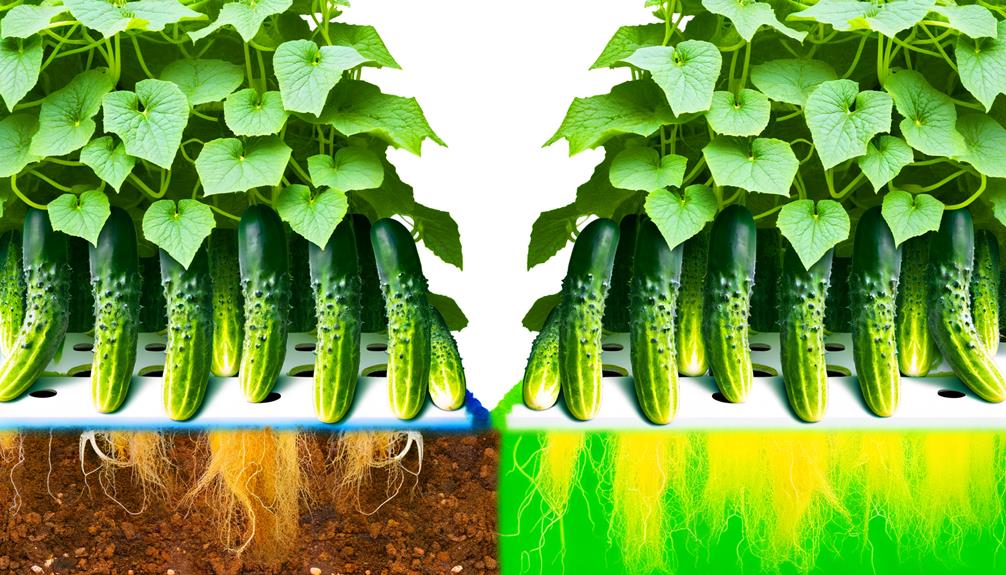
When selecting nutrients for hydroponic cucumber cultivation, growers must evaluate the advantages and limitations of both organic and synthetic options to optimize plant health and yield.
Organic nutrients, derived from natural sources, enhance microbial activity and soil health, but they often have inconsistent nutrient concentrations and slower release rates.
Synthetic nutrients, on the other hand, provide precise, readily available nutrient formulations, promoting rapid plant growth and higher yields. However, they may lack beneficial microorganisms and contribute to the buildup of salts in the system.
Data indicate that while synthetic nutrients can achieve up to a 30% increase in yield, organic solutions are preferred for sustainable and eco-friendly practices.
Ultimately, the choice depends on balancing immediate productivity with long-term sustainability goals.
Best Practices
Implementing best practices in hydroponic cucumber cultivation involves precise monitoring of nutrient solution pH levels, maintaining an ideal range of 5.5 to 6.5 to guarantee maximum nutrient uptake and plant health.
Consistent monitoring and adjustments are vital to avoid nutrient lockout or toxicity. Additionally, maintaining optimal electrical conductivity (EC) levels between 2.0 to 3.0 mS/cm guarantees balanced nutrient availability.
Here are three essential best practices:
- Regular pH and EC Monitoring: Utilize reliable pH and EC meters to check solution levels daily.
- Nutrient Solution Replacement: Change the nutrient solution every two weeks to prevent imbalances and pathogen build-up.
- Oxygenation: Ensure adequate aeration in the nutrient solution to promote root health and prevent anaerobic conditions.
These practices foster robust cucumber growth and yield.
Conclusion
A meticulously managed hydroponic nutrient solution is essential for cultivating cucumbers.
Ensuring essential elements, optimizing macronutrient ratios, and acknowledging micronutrient importance enhances plant productivity.
Water quality, pH levels, and regular monitoring mitigate potential deficiencies.
Comparing organic versus synthetic nutrients offers growers various viable options.
Adhering to agronomic best practices, such as systematic adjustments and precise nutrient delivery, promotes robust cucumber crop health and yield.

